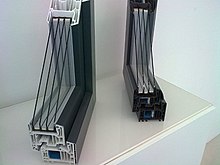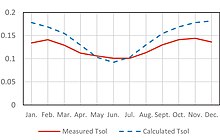

Quadruple glazing (quadruple-pane insulating glazing) is a type of insulated glazing comprising four glass panes, commonly equipped with low emissivity coating and insulating gases in the cavities between the glass panes. Quadruple glazing is a subset of multipane (multilayer) glazing systems. Multipane glazing with up to six panes is commercially available.
Multipane glazing improves thermal comfort (by reducing downdraft convection currents adjacent to the windowpane), and it can reduce greenhouse gas emissions by minimising heating and cooling demand. Quadruple glazing may be required to achieve desired energy efficiency levels in Arctic regions, or to allow for higher glazing ratios in curtain walling without increasing winter heat loss. Quadruple glazing allows building glazing elements to be designed without modulated external sun-shading, given that the low thermal transmittance of having four or more glazing layers enables solar gain to be adequately managed directly by the window glazing itself. In Nordic countries, some existing buildings with triple glazing are being upgraded to glazing with four or more layers.
Features


With quadruple glazing, the center-of-panel U-value (Ug) of 0.33 W/(mK) is readily achievable. With six-pane glazing, a Ug value as low as 0.24 W/(mK) was reported. This brings several advantages, such as:
- Energy efficient buildings without modulated sun shading
- The desired overall window thermal transmittance value of lower than about 0.4 W/(mK) is possible without having to depend on modulated external shading. A study by Svendsen et al. showed that at such low window U-values, glazing with moderate solar gain performs comparably to glazing of comparable U-value with variable external shading and high solar gain. This is so because with improved overall U-values, a building's heating demand diminishes, to the point that wintertime solar heat gain alone may be enough to heat the building.
- Pronounced seasonal-dependence of the solar gain
- Due to incidence-angle-dependent Fresnel reflections, the optical characteristics of multipane glazing, also notably vary seasonally. As the sun's average elevation varies throughout the year, the effective solar gain tends to be meaningfully less in the summer. The effect is also visible to an extent to the naked eye.
- Comfort for occupants
- When compared to traditional double-pane or triple-pane windows with mechanical or structural shading arrangements, multipane glazing enables easier viewing between indoor and outdoor environments. A low U-value maintains inside glass temperatures at a more uniform level throughout the year. During the winter, downwards convection currents (downdrafts) are very small, thereby enabling people seated near such a multipane window to feel as comfortable adjacent to the window as they would feel if they were seated adjacent to a solid wall. However, occlusion or shading might still be wanted for purposes of privacy.
- Nearly zero heating building
- In 1995, it was predicted that with a glazing U-value of 0.3 W/(mK) zero-heating building could be attained. It has also been shown that the heating demand might be decreased to nearly zero for glazed buildings with system U-values as low as 0.3 W/(mK). Theoretically, in the summer, the remaining cooling demand could be satisfied by photovoltaic generation alone, with the greatest need for cooling nearly coinciding with the strongest sunlight incident on solar panels. However, in practice, temporal lags between cooling demand and the output from solar panels could occur due to factors such as ambient humidity and the need for dehumidification, as well as the thermal inertia of the building and its contents.
Engineering

Multipane glazing is often designed with thinner intermediate glass panes in order to save weight. To prevent intermediate panes from thermal stress cracking it is sometimes required to use heat-strengthened glass. With more than three glass panes, special care must be taken of the spacer and sealant temperatures as intermediate glass panes in contact with these glazing elements can readily exceed design temperature limits of respective materials due to solar radiation (irradiance) heating.

Solar irradiance heating of intermediate glass panes increases substantially with an increased number of glass panes. Multipane glazing must be carefully designed to account for the expansion of the insulating gases that are placed between the glass layers, because such gaseous expansion becomes an increasingly important consideration as the number of glass panes is increased. Special breather vents, as well as small vents communicating between the layer spaces, can be incorporated in order to manage this glass-bulging effect. Finite element analysis is often used to calculate appropriate glass sheets' strengths. Calculating static equilibrium with thin glass panes used in multipane glazing may involve nonlinear plate mechanics.
Performance
Double-pane windows have been the industry standard for decades. They represent a vast improvement over single-pane windows but the potential for even greater energy savings with more highly insulating windows has been elusive. Recent price reductions in the thin glass used in both smartphones and flat-screen TVs, as well as in the krypton gas used in halogen lights, however, have made it possible to build lighter, high- efficiency quad-pane windows at a lower cost. Researchers from the National Renewable Energy Laboratory evaluated two configurations of Alpen High Performance (an American manufacturer) quad-pane windows at an office building at the Denver Federal Center. Both configurations have the same thickness and a comparable weight as a standard commercial double-pane window—one model uses two layers of film suspended between two panes of standard glass, the other replaces the film with two panes of ultra-thin glass. Researchers found that on average, quad-pane windows saved 24% heating and cooling energy compared with a high-performing double- pane window. For new construction and window replacements, the quad-pane windows have payback between one and six years, depending on climate zone and utility rates.
See also
- Passive house
- Curtain wall (architecture)
- Window
- Passive solar building design
- History of passive solar building design
References
- ^ Kralj, Aleš; Drev, Marija; Žnidaršič, Matjaž; Černe, Boštjan; Hafner, Jože; Jelle, Bjørn Petter (May 2019). "Investigations of 6-pane glazing: Properties and possibilities". Energy and Buildings. 190: 61–68. doi:10.1016/j.enbuild.2019.02.033. hdl:11250/2589488.
- Krick, Benjamin. "Optimum glazing in the regions of Europe considering the embedded energy" (PDF). Passive House Institute. Retrieved 3 May 2019.
- ^ Vanhoutteghem, Lies; Skarning, Gunnlaug Cecilie Jensen; Hviid, Christian Anker; Svendsen, Svend (September 2015). "Impact of façade window design on energy, daylighting and thermal comfort in nearly zero-energy houses" (PDF). Energy and Buildings. 102: 149–156. doi:10.1016/j.enbuild.2015.05.018. S2CID 38055509.
- Kristiansen, Øyvind Meyer. "Höegh Eiendom først i Norge med innovativ fasadeløsning". Enova. Retrieved 23 May 2019.
- ^ Chmúrny, Ivan (January 2016). "Triple or Quadruple Glazing?". Applied Mechanics and Materials. 820: 242–247. doi:10.4028/www.scientific.net/AMM.820.242. S2CID 111693176.
- Feist, Wolfgang (1995). Erfahrungen mit Häusern ohne aktives Heizsystem. Darmstadt: IBK-Institut für das Bauen mit Kunststoffen.
- ^ "Quadruple insulated glass unit". MEM4WIN. Retrieved 16 Feb 2020.
- Starman, Bojan; Maček, Andraž; Rus, Primož; Obid, Štefan; Kralj, Aleš; Halilovič, Miroslav (19 February 2020). "Primary Seal Deformation in Multipane Glazing Units". Applied Sciences. 10 (4): 1390. doi:10.3390/app10041390.
- Grynning, Steinar; Jelle, Bjørn; Gustavsen, Arild; Gao, Tao; Time, Berit (2016). Multilayer Glazing Technologies: Key Performance Parameters and Future Perspectives. Aalborg, Denmark: CLIMA 2016 - Proceedings of the 12th REHVA World Congress, Vol. 2. pp. Article no. 187. Retrieved 3 May 2019.
- Anderson, Martin; Simon, Nilsson (2014). "Bulging of Insulating Glass Units - Numerical and Experimental Analysis". TVSM-5000. Lund, Sweden: Lund University.
- Halilovič, Miroslav; Maček, Andraž; Mole, Nikolaj; Koc, Pino; Plešnik, Filip; Rus, Primož; Žnidaršič, Matjaž; Kralj, Aleš (1 December 2023). "Accurate determination of the static equilibrium in insulating glass units under climatic loading". Journal of Building Engineering. 80. doi:10.1016/j.jobe.2023.107955. hdl:20.500.12556/RUL-152298.
- https://www.gsa.gov/cdnstatic/Applied_Research/GPG%20048-Findings-Quad%20Pane%20Windows.pdf
External links
- quadruple glazing seasonal energy transmittance video
- 6-pane glazing destructive test video
- Reflex - Q-Air multipane glazing
- EN 1279:2018 Glass in building — Insulating glass unit
- EN 16612:2019 Glass in building — Determination of the lateral load resistance of glass panes by calculation